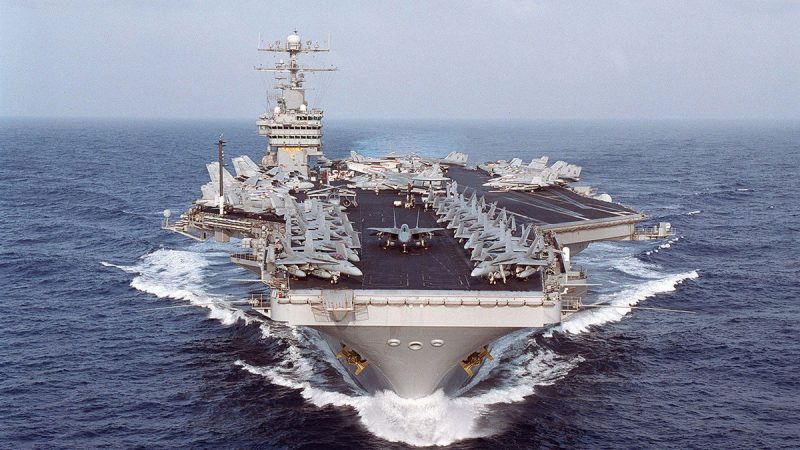On Thursday night, over 100 weapons struck 60 targets in 16 Houthi rebel areas across Yemen. The scope of the strike on 16 different areas tells me that U.S. Central Command (CENTCOM) has been watching the Houthis and developing targets for months. Every target was evaluated to reduce collateral damage to civilians, and in fact, that’s another reason for striking at night.
At the center of the action was the F/A-18EF Superhornet. Yes, it’s the same Superhornet plane flown by Tom Cruise in the movie ‘Top Gun: Maverick.’
Of course, these Superhornets are playing for much higher stakes. They have Iran and China watching. And the world’s just seen a turnaround in tactics worthy of a Hollywood thriller.
For weeks, U.S. Navy ship crews and F/A-18EF Superhornet pilots in the Red Sea have been under tight limits.
Since the Houthis began their Red Sea war in October, U.S. Central Command’s rules dictated that the U.S. and allies could only shoot down the Houthi missiles and drones at the last minute. Sometimes the missiles and drones – all supplied by Iran – closed to within mere seconds of impact.
Retired Admiral John ‘Black’ Nathman (an actual Top Gun instructor) once famously told Congress he liked the Superhornet enough to kiss it on the lips.
The Houthis got to take the first shot. Every time. And all their warehouses, drone launch areas, airfields and radars ashore in Yemen were off limits. Talk about frustrating.
Thursday, at last, the Superhornets switched from drone slayers to bomb-dropping mode.
The slant-tail, twin-engine F/A-18EF Superhornet first flew combat over 20 years ago and it’s a plane the Navy aviators love. Retired Admiral John ‘Black’ Nathman (an actual Top Gun instructor) once famously told Congress he liked the Superhornet enough to kiss it on the lips.
Unleashing the Superhornets was long overdue. The USS Eisenhower aircraft carrier strike group has been in action since Nov. 4. Back on Dec. 26, Superhornets from the Ike were part of a 10-hour battle with the Houthis which started at 6:30 am. Up in the Red Sea, U.S. Navy destroyer USS Laboon was under attack and knocking down drones. Ike launched its Superhornets and the ship and planes together shot down 12 kamikaze drones, three anti-ship missiles and two land-attack cruise missiles.
Then came the last straw. On Tuesday, Superhornets joined three U.S. and one British destroyer in shooting down 18 Houthi drones and missiles.
The Houthis had been warned, and it was time for the Superhornets to strike back. Getting after the nests of Houthi capability supplied by Iran is a much more effective strategy. The Pentagon calls this ‘left of launch.’
The Superhornets carry advanced weapons like the satellite-guided Joint Direct Attack Munition or JDAM and the Joint Standoff weapon, a glide bomb that can hit targets from outside some air defense zones. Both weapons are just right for taking out the fixed target sites where the Houthis ready the lethal drones and missiles supplied by Iran.
Don’t forget the Superhornets and other aircraft carried out their strikes at night. That means catapult launches into the blackness, air refueling from tanker planes in the dark, and if they were lucky, maybe a streak of dawn for landing back on the ship.
Superhornets can also function as buddy tankers. After a combat strike, another Superhornet carrying extra ‘bags’ of gas can top off the homebound aircraft with enough fuel to land on the aircraft carrier safely.
Sure, there were probably a few high-fives in the colorfully-decorated squadron ready rooms after the mission. However, aircraft carrier flight operations don’t stop. Superhornet crews are ready for additional missions as needed – to intercept Houthi missiles, or hit fixed targets again.
It’s no bad thing that the U.S. and Britain attacked Houthi drone and missile launch capabilities right before the Jan. 13 Taiwan elections.
Remember China has warships near the Red Sea gateway on an ‘anti-piracy’ mission. Xi Jinping’s generals can do the math. While China’s defenses in its home waters are much stiffer, the fact is that the Tomahawk missiles and Superhornets would be adept drone slayers and bomb-droppers in the Pacific, too.
In coming days, we’ll hear more about the Tomahawk cruise missiles fired by Navy submarines and ships. And about the role of the U.S. Air Force combat planes, flying from bases whose national hosts don’t like to appear in the press.
We already know Britain’s Royal Air Force Typhoon fighter jets operating out of their ever-useful base in Cyprus employed precision Paveway bombs in the strike.
Time will tell if the strikes were enough to suppress Houthi operations and get Red Sea shipping traffic back to normal.
If not, I guarantee you that Central Command has plenty more Houthi military aim points lined up and ready to strike. That is a lesson for China to heed as well.

